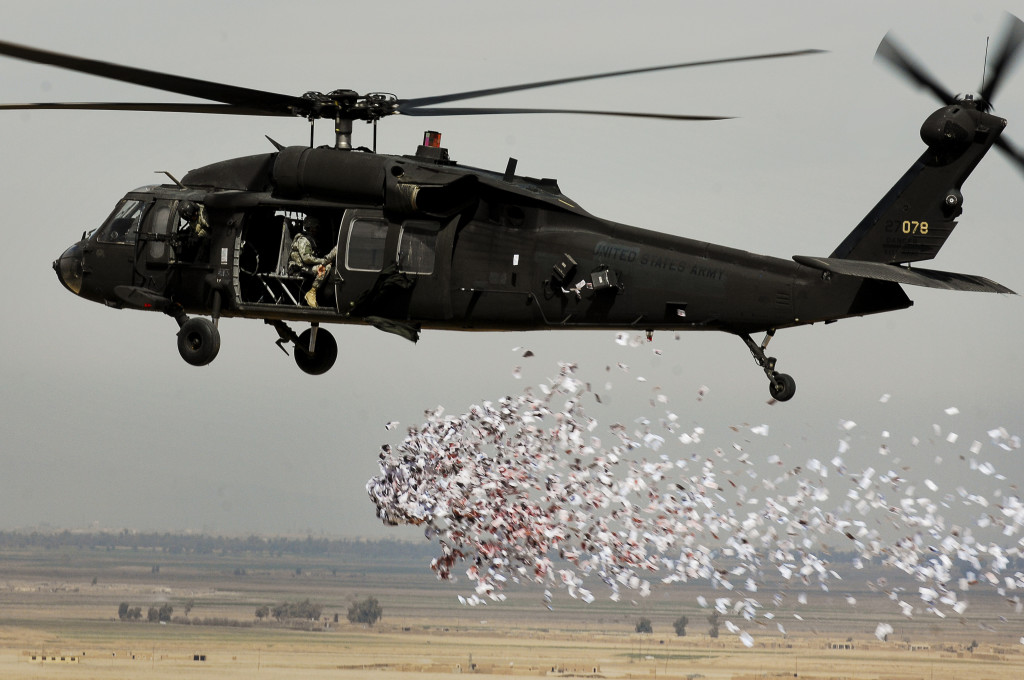Summary
The recent war between Israel and Palestine has brought up the topic of etiquette in warfare. This document is intended to offer an examination of wartime dialog.
Advanced Warnings
Leaflets during wartime were popularized in the 1940s and 1950s and used as a way to deliver a message over a wide geographic area. A humanitarian use of leaflets is to “Inform people where to find airdropped food, how to open and consume it, and when it comes.” They are also used to encourage surrender.
Wartime App
Israel has created a Wartime App that citizens can use to track inbound missiles and presumably, like a weather app, they can plan their day around missile attacks.
At some point a similar app could be developed for one’s enemies as an alternative to phone calls, text messages and leaflets (described below).
Phone Call, Text Message, or Leaflet
Leaflets are another common method of communication when waging war against people who are in a region where there’s poverty and not everyone has phones. However, if you’re waging war with people who are in severe poverty and suffering, it’s possible you should reconsider and offer humanitarian aid instead of waging a war.
Prior to firing rockets at someone, is it more polite to send a text message or is blowing up someone’s home (for example) something that warrants a phone call ahead of time? The benefit of the phone call is that you can find out if they are home, and perhaps ask, “Is this a convenient time to blow up your home? If not, how would next Tuesday afternoon be?”
This sounds like material for a Monty Python skit, yet it’s precisely the challenge facing those who wish to engage in more humane warfare. The goal, presumably, is to destroy the weapons of war without harming people.
Video Footage – Example of Phone Call
In the video footage below the Israeli forces have an extended conversation over three days prior to attacking a hospital to confirm that there are no non-combatants in the building and that it’s only being used by the military.
Video Description: Hamas has turned Wafa Hospital into a command center and a rocket-launching site. Hamas has fired at Israel and at IDF forces from the hospital. As a result, the IDF repeatedly conveyed warnings to the hospital staff and urged civilians to leave the area. Hamas continued firing from the hospital. In response, the IDF targeted specific sites and terrorists within the hospital grounds. Secondary explosions can be seen, confirming IDF intelligence about the site. (Source)
Are Advanced Warnings Effective?
Here are some points to consider regarding the effectiveness of advanced warnings:
- Rocket launchers are moveable. So, if rockets are being launched from a residential area, those who are launching the rockets can keep moving and no amount of destruction will stop them. In fact, the only outcome will be the destruction of non-military targets.
- Combatants also receive warnings. If a warning is being provided, isn’t is plausible that the person on the other end of the phone is the person launching rockets at you? With a warning, they can just move their rocket launcher to a new location. Even if you’re not calling militants on the phone, the militants can see people evacuating and this warns them of an attack.
- Damage and suffering aren’t averted. Because the damages of war are measured in fatalities, there is a lot of suffering that goes undocumented and unacknowledged. The loss of one’s home and personal belongings along with the fear of urgent evacuation is traumatic. People often are injured or killed in such an environment. Being displaced, living in refugee camps, coping without proper sanitation, food, or housing, creates ongoing suffering. So, despite one’s best efforts to be thoughtful, the outcome is almost always tragic.
Differing Rules of Engagement
Another issue that arises in warfare are the differing expectations that each side has.
In the conflict between Israel and Palestine, the Hamas army is hiding weapons in public facilities and homes — presumably thinking, “We’ll be safe here. Nobody would launch an attack against a hospital or school, right?”
Yet, some people expect clearly marked and visible munitions depots and military compounds to target.
It’s been argued that Hamas intentionally places their rockets and weapon stockpiles near schools, hospitals, homes, and places of worship, in an effort to inflict damage on the residents of Gaza. While that’s plausible, it’s more likely that they are doing this as a way of following traditional rules of engagement — with the understanding and believe that they are safe if they are surrounded by civilians.
In most countries, if a terrorist or militant is taking cover in a school or hospital, the response isn’t to blow up the facility with everyone inside of it. The response is to negotiate, or take some form of action that doesn’t put civilians in harms way.
One aspect of the American Revolutionary War was the extent to which there were differing styles of warfare. The British were called Red Coats because of their elaborate and decorative uniform. Wearing a bright decorative uniform made it easier to differentiate between combatants and civilians. Stories are told about how the Red Coats would wear their uniform and march in straight lines through open fields making them easy targets for the Blue Coats who were engaging in guerrilla warfare by hiding in bushes and marching out of rank (not in Column formation). Commentary about that war suggests that the stories of guerrilla warfare were exaggerated.
Final Thoughts
If we’re really that concerned about harming people, so much so as to warn them ahead of time, why not just avoid the war altogether?

